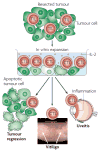Immunotherapy of autoimmunity and cancer: the penalty for success
- PMID: 19008897
- PMCID: PMC2764117
- DOI: 10.1038/nri2438
Immunotherapy of autoimmunity and cancer: the penalty for success
Abstract
Advances in our understanding of autoimmunity and tumour immunity have led to improvements in immunotherapy for these diseases. Ironically, effective tumour immunity requires the induction of the same responses that underlie autoimmunity, whereas autoimmunity is driven by dysregulation of the same mechanisms that are involved in host defence and immune surveillance. Therefore, as we manipulate the immune system to treat cancer or autoimmunity, we inevitably unbalance the vital mechanisms that regulate self tolerance and antimicrobial resistance. This Science and Society article aims to dissect the conundrum that is inherent to the concept of immunotherapy and highlights the need for new and more specific therapeutic approaches.
Figures


References
-
- Busnach G, et al. Immunosuppression and cancer: a comparison of risks in recipients of organ transplants and in HIV-positive individuals. Transplant Proc. 2006;38:3533–3535. - PubMed
-
- Bongartz T, et al. Anti-TNF antibody therapy in rheumatoid arthritis and the risk of serious infections and malignancies: systematic review and meta-analysis of rare harmful effects in randomized controlled trials. JAMA. 2006;295:2275–2285. - PubMed
-
- Chatenoud L. Immune therapies of autoimmune diseases: are we approaching a real cure? Curr Opin Immunol. 2006;18:710–717. - PubMed
-
- Scott CT. The problem with potency. Nature Biotechnol. 2005;23:1037–1039. - PubMed
Publication types
MeSH terms
Substances
Grants and funding
LinkOut - more resources
Full Text Sources
Other Literature Sources

